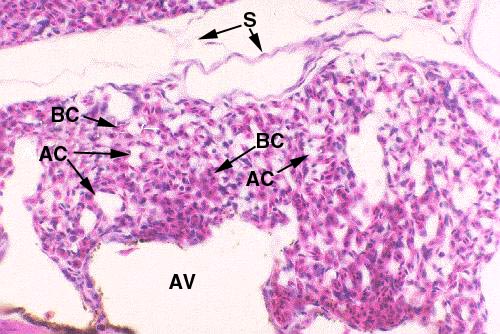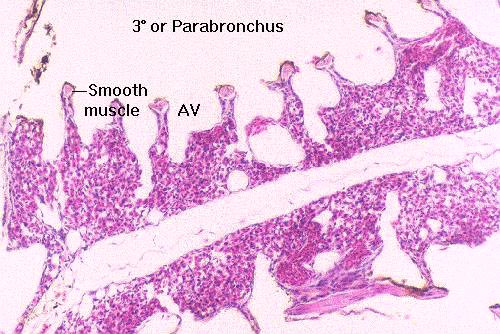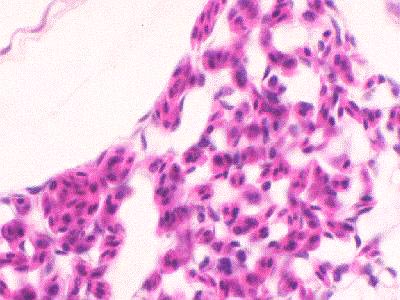
 The
air vesicles (AV) are bay-like extensions off the
parabronchi. Here you see the way they come off, and the smooth
muscle in the walls of the parabronchus itself. The air vesicles are
the sites of gas exchange, or more properly speaking, their "walls" are. These consist of two kinds of capillaries: one type for air and
one type for blood. In the image below right, the nature of the wall of the air vesicle (AV) is a
little plainer. Notice the nucleated erythrocytes in the blood
capillaries(BC). These blood vessels are just barely large enough for the
passage of the blood cells, and like any capillary they're
constructed of a thin simple squamous endothelium.
The
air vesicles (AV) are bay-like extensions off the
parabronchi. Here you see the way they come off, and the smooth
muscle in the walls of the parabronchus itself. The air vesicles are
the sites of gas exchange, or more properly speaking, their "walls" are. These consist of two kinds of capillaries: one type for air and
one type for blood. In the image below right, the nature of the wall of the air vesicle (AV) is a
little plainer. Notice the nucleated erythrocytes in the blood
capillaries(BC). These blood vessels are just barely large enough for the
passage of the blood cells, and like any capillary they're
constructed of a thin simple squamous endothelium.

As is also true in mammalian lung, the endothelium of the capillary is extremely tenuous, and so is the epithelium of the adjacent air capillaries, so as to provide only the minimum barrier to gas exchange. Any given blood capillary is in continuous contact with several air capillaries (AC) (and vice versa) through the whole thickness of the wall of the air vesicle. The air vesicles of this parabronchus are separated from the adjacent ones by septum of connective tissue (S).
In a high power image like the next one you can better make out the
relationship of the two types of capillary. The air
capillaries are recurrent loops; they begin in one part of the
air vesicle and loop back to it. Air moving through the lung moves
through these thin epithelial walled vessels in one direction.
The blood capillaries move blood in the opposite direction. Thus as the blood absorbs oxygen across the barrier of the two epithelial layers (the air capillary wall and the blood capillary endothelium); it's always moving into a stream of air in which the oxygen content is at maximum levels. This counter-current flow is responsible for a good part of the efficiency of avian lungs. The close proximity of one blood vessel to several air vessels and vice versa also promotes rapid and complete saturation of the blood with oxygen.
Unlike the tidal in and out ventilation of mammalian lungs, in which a part of the volume is "stale" air, and unlike the mammalian structure with a lot of blind alleys and dead space, the avian lung is a continuous flow system. Air comes in and goes out in a more or less steady stream, propelled by the bellows action of the air sacs and constantly coursing over the minute blood vessels. Birds need a system like this to provide for their very high demands for oxygenation of the massive flight muscles.
Avian lung; H&E stain, paraffin sections, 200x and 400x